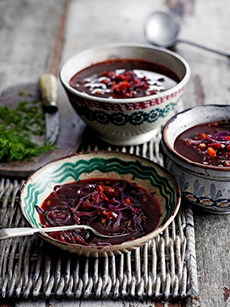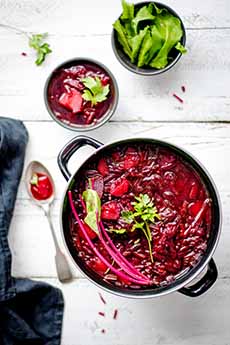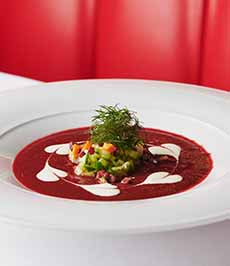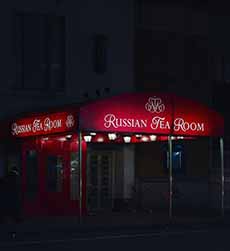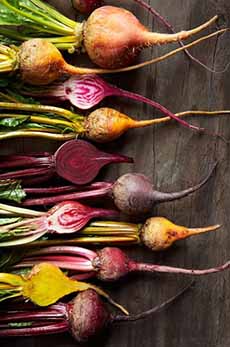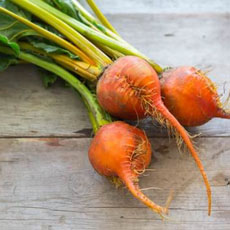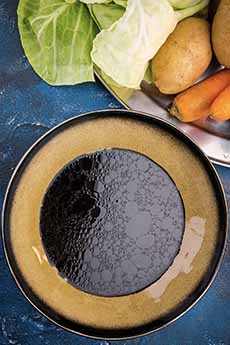The Russian Tea Room Borscht Recipe & The History Of Borscht
|
Chilled borscht in the summertime? We buy it at Zabar’s by the quart, along with chilled cucumber soup, fruit soup, and gazpacho. In the summer, there are more chilled soups than you can shake a stick at*, as my Nana would say. Our personal Top 10 favorites (including those previously mentioned): While chilled soups are typically served as a first course, we like to serve the fruit soups as a light summer dessert. This brings us back to borscht. Recently, we had a bowl of hot borscht at the legendary, luxurious, and enchanting Russian Tea Room in New York City (photos #4, #5, and #6). We liked it so much that we asked for the recipe, which we’ve shared below. We then added a twist to the second batch we made: We used golden beets instead of red ones. A bit about golden beets (photo #7) is included in: Today they are still a specialty item, sold at specialty grocers, farmers markets, and through online seed retailers worldwide [source]. > National Homemade Soup Day is February 4th. > National Cold Borscht Day is May 22nd. > The different types of soup. > The history of borscht is below. See the finished recipe in photo #4. If you like to serve bread with your soup, pumpernickel or seeded rye are culturally good cultural choices, although brioche is always delicious. We like our pumpernickel or rye with sweet butter and crunchy coarse sea salt to sprinkle on top of it. (We enjoy this combination far more than salted butter, with the exception of a great salted butter, Vermont Creamery’s Cultured Butter With Sea Salt.) 1. BRING lightly salted water to a boil and reduce to a simmer. Add the chopped beets and carrots. Once the beets and carrots are cooked… 2. STRAIN and reserve water and vegetables, cool to room temperature. Once the vegetables are cooled, place them in a blender or food processor and purée. 3. ADD the beet juice, sour cream, and vinegar and adjust the seasoning. (Season to taste. You can start with 1 teaspoon each of salt and pepper. 4. BLEND. Once the purée is smooth and homogenous… 5. PUT the soup in the refrigerator to chill. To serve: 6. PLACE the soup in a bowl, and garnish with dill and sour cream. Borscht, also spelled borsch, borsht, or bortsch, is a beet soup that is popular in Slavic countries. It is a key component in Russian and Polish cuisines, although Ukraine is frequently cited as its place of origin, and borscht is their national dish. The name is thought to be derived from the Slavic word for the cow parsnip (a.k.a. common hogweed, Heracleum sphondylium), which is borschevik. In early Slavic cuisine, the stems, leaves, and flowers of the cow parsnip were made into soup or fermented, yielding something along the lines of sauerkraut. Beets Take Their Place The more flavorful cultivated beet eventually replaced the wild cow parsnip as the basis of the soup [source]. The beets also gave borscht its striking red/magenta color. It is commonly believed that the origins of modern borscht date to the 14th century, in the area that is today Ukraine. Old recipes seem to affirm that it was the Ukrainians who made the soup from beetroot. Originally a peasant food, borscht spread across regions, becoming a culinary staple for all classes [source]. Hundreds Of Recipes Evolve Today, the quintessential Ukrainian borscht is made with beetroot, potatoes, and pork fat (and of course, many variations thereof). But cooks everywhere added other ingredients according to both what they liked and what was growing in the region. By the end of the 19th century, borscht had spread as far as Persia, France, and, the U.S. (via Jewish immigration). Each country or cultural group has its different take on borscht: Recipes vary between Ashkenazi Jews, Belarusians, Georgians, Lithuanians, Poles, Ukrainians, and Russians. Even China has a take on borscht, called luó sòng tāng, or “Russian soup” [source]. What would you like in your borscht? In our family, cabbage, onions, and dill were added to the beets, and the soup was garnished with small boiled potatoes, sour cream, and more dill. Summer borscht was served cold, hot winter borscht added carrots and meat: brisket or flanken (short ribs). You can play with the recipe and add just about anything: *The origin of this phrase: In merry olde England, farmers controlled their sheep by shaking their staffs at the animals to indicate where the sheep should go—human herding instead of dog herding. When farmers had more sheep than they could control, it was said that they had “more than you can shake a stick at” [source]. †Doukhobors are a sect of Russian dissenters, many of whom now live in western Canada. Here’s more about them. |
|
|
|
CHECK OUT WHAT’S HAPPENING ON OUR HOME PAGE, THENIBBLE.COM.
|
||
